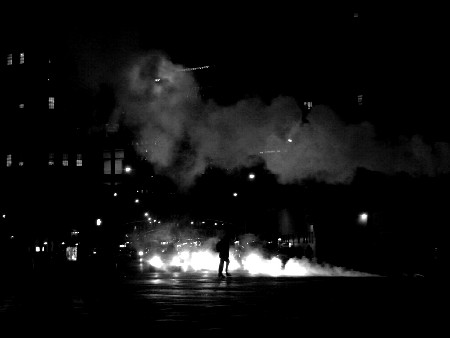Excerpt from an unpublished missive — the mythus of the underground.
The outsider, insubordinate, and risk-laden character of dance, legitimated in this sense through its criminalization, provides participants with an outlaw or rebel identity forged in an ambiguous relationship with the law. — Graham St John, Technomad@20
The underground resonates with flights from the drudgery of everyday life into realms of secrecy and substance, where liberated encampments of rebel fugitives revel in the immediatism of autonomous existence…
What is the underground? A glimpse of the unfound country of the unknown. In its myth, the underground is a place otherwise than what exists all around, a place where what will and wants to be can take place without hindrance; and it exists at a far cry from the laborious processes of representative politics, petitions, and protests. In this sense, the underground is a mythic place; it is a distant and ever-receding horizon precisely because it is no secret. This is no more apparent than in the popular press, where the underground proclaims its mythic status as that fertile place from which the unknown emerges.
It appears hidden in plain sight.
The efficacy of the underground is oft discredited when viewed from the study of a particular cultural enclave. In the sobering reality of the 21C, the place of an imaginative rebellion, and of the entanglement of the avant-guarde with political organisation, or more precisely, the entwinement of politics and aesthetics, has been oft discredited since Benjamin attempted to distinguish the aestheticization of politics – which accordingly can only result in war – from the politicization of art. Myth is a form aestheticization; it is fiction given force. A myth may, or may not, be exactly true, but the veritas of its actuality is always unverifiable, and what is more true than its de facto accountability is the force of its suggestiveness, which is measured only by the limitations of its imaginary.
Disseminated throughout the 1980s in print and worldwide through online BBS networks and the early public internet in the 1990s, Hakim Bey’s communiques of the Temporary Autonomous Zone (TAZ), a “guerilla operation which liberates an area (of land, of time, of imagination) and then dissolves itself to re-form elsewhere/elsewhen, before the state can crush it” (Bey 1991 TAZ@101), have catalysed generations of “happy mutants” (Frauenfelder, Sinclair, Branwyn 1995), be they ravers, anarcho-punks, drop-outs or neo-situationists and surrealists, through the “poetic terrorism” of the mythic underground. Reading the TAZ communiques as they were leaked from some safe haven of the mystic anarchist was in itself a transformative undertaking. Apparently communicating from the position of the TAZ, performing in his text the narrative of an experienced initiate in occult practices and mythic rituals of liberation, and writing with the uninhibited parlance of the poetic imaginary, Bey disseminated not only the mythus of immediatist autonomy, but put myth to work in its service. The legends of the Hashisheen, the invocations of ritual chaos, the dreams of pirates and corsairs…
The dream of the underground, as disappearance from overbearing social constraints and the accountability of the State, was sought through means as unreal as they were nearly possible. In Bey’s text, the practices of occult magick and symbolic surrealism offered creative resistance against restricted living that surpassed, through their jouissance, the sober methods of organised political representation. The use of myth hinged precisely on the moment when the unbelieveable elements of Bey’s text came into contact with possibility. That a symbolic tactic of, say, incanting a ritual spell against a corporation, might hold as much leverage as – if not more than – writing letters to governmental representatives demonstrates a coherent grasp of the power of symbols. For by deploying symbolic practices against a society drowning in advertising and marketing, and overflowing with such an abundance of surveillance data and harvested information that no possible aggregation could compute its many dimensions, spaces of slippage and misrepresentation could be opened in which something other could take place – and here is where Bey gestured toward an actual event, a liberation of place, a Temporary Autonomous Zone. A slippage between symbols, between map and reality, could be put to work to enact disappearance as a strategy in which the possibility of living otherwise could be put into place. To put it in Paolo Virno’s terms, the TAZ is sought by way of “engaged withdrawal” – withdrawal not as retreat, but as a means to clear new space – and where “Exodus is the foundation of a Republic”; and like Freud’s relation between Ego and Id (Wo Es war, soll Ich werden), where I shall be is where the State shall be not: “if Republic, then no longer State” (Virno Virtuosity 1996@197).
[…]
Full version yet to be published.
Tags: disappearance, exodus, TAZ, underground, Virno
.tinyUrl for this post: | https://tinyurl.com/y2mu86lg .





 RT
RT 
the Myth of the Underground: new post on fugitive.philosophy http://bit.ly/cWPXEQ #exodus #TAZ #Virno #autonomia #underground